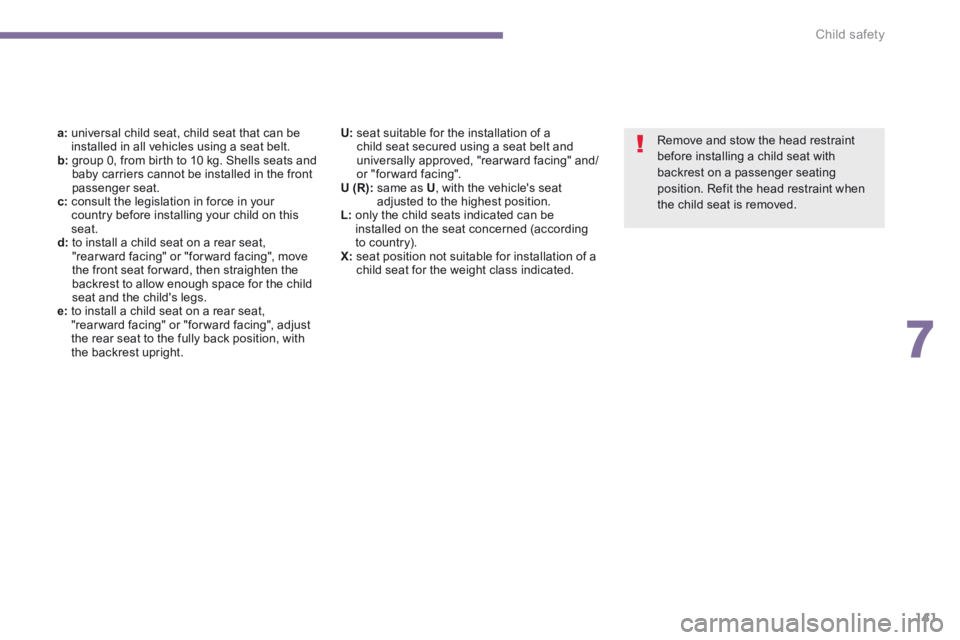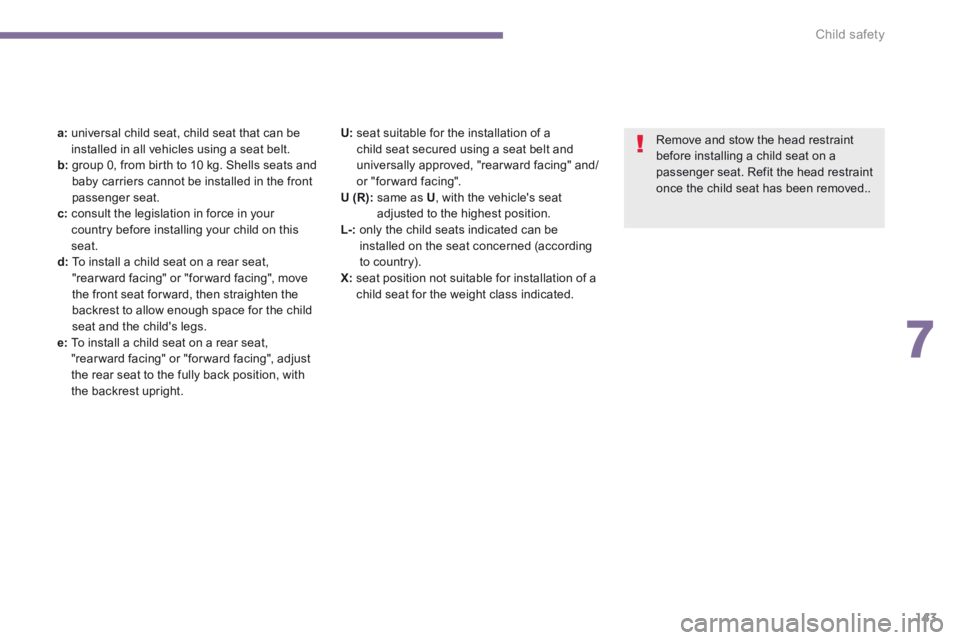Page 5 of 404

.
.
Contents
Direction indicators 152Hazard warning lamps 152Hor n 152Tyre under-infl ation detection 153ESC system 155Front seat belts 158Airbags 162
Safety
Electric parking brake 166Hill start assist 170Head-up display 173Distance alert 175Speed limiter 178Cruise control 181Manual gearbox 184Gear shift indicator 185Electronic gearbox 186Automatic gearbox 191Stop & Start 195Parking sensors 198Reversing camera 200Parking space sensors 201
Driving
Emergency or assistance 265PEUGEOT Connect Media Navigation (NG4 3D) 269PEUGEOT Connect Navigation (RT6) 313PEUGEOT Connect Sound (RD5) 367
Audio equipment and telematics
Visual search
Alphabetical index
Bonnet
204Running out of fuel (Diesel) 205Petrol engines 206Diesel engines 207Checking levels 208C h e c k s 2 11
Checks
Temporary puncture repair kit 213Changing a wheel 223Snow chains 230Changing a bulb 231Changing a fuse 23712 V battery 244Energy economy mode 247Changing a wiper blade 248Towing the vehicle 248Towing a trailer 250Fitting roof bars 252Very cold climate screen 253Accessories 254
Practical information
Petrol engines 256Petrol weights 257Diesel engines 258Diesel weights 259Dimensions 263Identifi cation markings 264
Technical data
Page 72 of 404
Comfort
70
Table position, front passenger seat
This position, associated with that of the rear seats, allows you to transport long objects inside the vehicle. The maximum weight on the seat is 30 kg.
Folding the seat backrest
Raise the armrest and fold up the "aircraft" style table, fixed on the back of the seat. Check that no object, either on or underneath the seat, could hinder its movement. To make the operation easier, place the head restraint in the low position (if the seat is in the fully for ward position). If your vehicle is fitted with the video pack, place the protective cover on the head restraint. Lift the control, located behind the seat, then guide the seat back for wards.
Returning the seat to the normal position
Guide the seat backrest rear wards until it locks in place.
When the seat backrest is in this position, only the 2 nd row passenger seat located behind the driver can be used.
Page 134 of 404
Child safety
132
General points relating to child seats
Although one of PEUGEOT main criteria when designing your vehicle, the safety of your children also depends on you.
For maximum safety, please observe the following recommendations: - in accordance with European regulations, all children under the age of 12 or less than one and a half metres tall must travel in approved child seats suited to their weight , on seats fitted with a seat belt or ISOFIX mountings * , - statistically, the safest seats in your vehicle for carr ying children are the rear seats, - a child weighing less than 9 kg must travel in the "rearward facing" position both in the front and in the rear.
* The rules for carrying children are specific to each country. Refer to the legislation in force in your country.
PEUGEOT recommends that children should travel in the outer outer outerrear seats of your vehicle: - "rearward facing" up to the age of 3,
- "forward facing" over the age of 3.
Page 142 of 404
Child safety
140
Installing child seats using the seat belt
In accordance with European regulations, this table indicates the options for installing child seats secured using a seat belt and universally approved (a)in accordance with the weight of the child and the seat in the vehicle.
Weight of the child and indicative age
Seat
Under 13 kg
(groups 0 ( b ) and 0+) Up to approx 1 year
From 9 to 18 kg
(group 1) 1 to 3 years approx
From 15 to 25 kg
(group 2) 3 to 6 years approx
From 22 to 36 kg
(group 3) 6 to 10 years approx
Front passenger seat ( c ) with height c ) with height cadjuster
U (R)U (R)U (R)U (R)
Front passenger seat (c) without height adjuster XXXX
5 seats (2 rows)
Outer rear seats (d)(e)U * U * U * U *
Centre rear seat (d)(e)UUUU
* Precautions are required when fitting a child seat with a support leg . Refer to the section "Installing a child seat with a support leg" for more information.
Page 143 of 404

7
Child safety141
Remove and stow the head restraint before installing a child seat with backrest on a passenger seating position. Refit the head restraint when the child seat is removed.
a: universal child seat, child seat that can be installed in all vehicles using a seat belt. b: group 0, from birth to 10 kg. Shells seats and baby carriers cannot be installed in the front passenger seat. c: consult the legislation in force in your country before installing your child on this seat. d: to install a child seat on a rear seat, "rear ward facing" or "for ward facing", move the front seat for ward, then straighten the backrest to allow enough space for the child seat and the child's legs. e: to install a child seat on a rear seat, "rearward facing" or "forward facing", adjust the rear seat to the fully back position, with the backrest upright.
U: seat suitable for the installation of a child seat secured using a seat belt and universally approved, "rearward facing" and/or "for ward facing". U (R): same as U , with the vehicle's seat adjusted to the highest position. L: only the child seats indicated can be installed on the seat concerned (according to country). X: seat position not suitable for installation of a child seat for the weight class indicated.
Page 144 of 404
Child safety
142
Weight of the child and indicative age
SeatUnder 13 kg (groups 0 (b) and 0+) Up to approx 1 year
From 9 to 18 kg (group 1) 1 to 3 years approx
From 15 to 25 kg (group 2) 3 to 6 years approx
From 22 to 36 kg (group 3) 6 to 10 years approx
Front passenger seat (c)with height adjuster
U (R)U (R)U (R)U (R)
Front passenger seat (c) without height adjuster XXXX
7 seats (3 rows)
Outer rear seats 2nd row (d)(e)U * U * U * U *
Centre rear seat 2nd row (d)(e)UUUU
Rear seats 3rd row UUUU
* Precautions are required when fitting a child seat with a support leg . Refer to the section "Installing a child seat with a support leg" for more information.
Page 145 of 404

7
Child safety143
a: universal child seat, child seat that can be installed in all vehicles using a seat belt. b: group 0, from birth to 10 kg. Shells seats and baby carriers cannot be installed in the front passenger seat. c: consult the legislation in force in your country before installing your child on this seat. d: To install a child seat on a rear seat, "rear ward facing" or "for ward facing", move the front seat for ward, then straighten the backrest to allow enough space for the child seat and the child's legs. e: To install a child seat on a rear seat, "rearward facing" or "forward facing", adjust the rear seat to the fully back position, with the backrest upright.
Remove and stow the head restraint before installing a child seat on a passenger seat. Refit the head restraint once the child seat has been removed..
U: seat suitable for the installation of a child seat secured using a seat belt and universally approved, "rearward facing" and/or "for ward facing". U (R): same as U , with the vehicle's seat adjusted to the highest position. L-: only the child seats indicated can be installed on the seat concerned (according to country). X: seat position not suitable for installation of a child seat for the weight class indicated.
Page 148 of 404
Child safety
146
Seating positions for installing ISOFIX child seats
In accordance with European Regulations, this table indicates the options for installing ISOFIX child seats on seats in the vehicle fitted with ISOFIX mountings. In the case of universal and semi-universal ISOFIX child seats, the ISOFIX size category, determined by a letter between A and G , is indicated on the child seat next to the ISOFIX logo.
Weight of the child / indicative age
Less than 10 kg (group 0) Up to approx. 6 months
Less than 10 kg (group 0) Less than 13 kg (group 0+) Up to approx. 1 year
From 9 to 18 kg (group 1) From approx. 1 to 3 years
Type of ISOFIX child seatShell"rearwards-facing""rearwards-facing""forwards-facing"
ISOFIX size categor yFGCDECDABB1
Front passenger seat XXXX
5 seats (2 rows)
Outer rear seats IL- SU * IL- SU * IL- SU * IUF * IL- SU *
Centre rear seat XIL- SUIL- SUIUF IL- SU